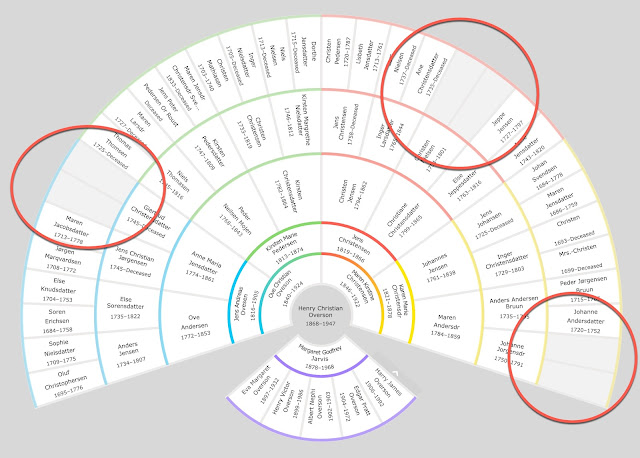The highly popular fan chart view of genealogical relationships is usually misleading. The attention of the researcher is immediately drawn to the blank spaces and frequently, the decision is made to look for the missing ancestor. This happens with pedigree charts when the researcher clicks back to the "end of the line" and tries to find the missing person. A pedigree chart is not a puzzle where you are looking for missing pieces no matter how compelling this analogy is. Each of the individuals in pedigrees, family group sheets, or other lists must have a demonstrable parent/child relationships. When there are no citations to historical records that contain these relationships, the ancestral line ends. This might seem like an obvious irrefutable principle, but it is frequently ignored.
Now, if you look at the fan chart image above, you can see three couples that are missing. But the real question is whether the individual in the center of the chart is related to any of these people at all. This fan chart appears to show that the missing people are related to the one in the middle position. The only way you and anyone else can determine if there are supported relationships is to look at each person and verify the sources that indicate a parent/child relationship.
As a matter of fact, this particular line is very likely wrong. Here is a look at the husband in the generation before the blank space.
I could go on and on, but the fact that the blank spaces are usually not the actual end of the line, is very common. Oh, by the way, if you don't see what is wrong with the above screenshot, you probably need to learn something about Danish records and naming patterns in the 1700s.
One hint is this: the records attached as sources show Peder Jorgensen married to Johanne Andersdatter in Tornby, Hojorring, Denmark in 1742 and another person named Peder Jorgensen Bruun married to Christensdatter in 1753 in Vidstrup, Hjorring, Denmark. The first child is born before the first marriage and the second child is born before the second marriage. In any event, the names do not match.
If you were to assume that all this was correct and start looking for the parents of Johhanne Andersdatter, you would probably not have the right people to start with. Don't jump to the Gap.






No comments:
Post a Comment